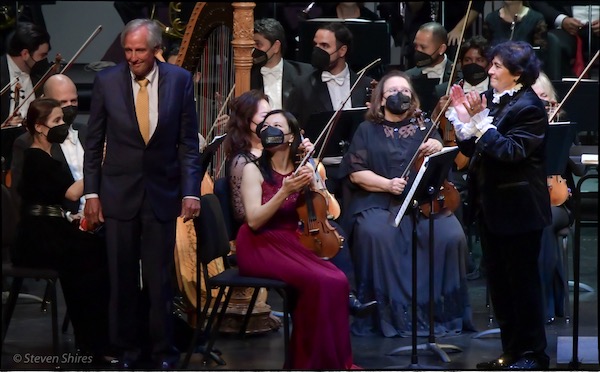South Florida Symphony gives committed advocacy to colorful Gottsch premiere

A rich and exciting new score by John Gottsch was the major event at the South Florida Symphony Orchestra’s concert Wednesday night at The Parker in Fort Lauderdale. Newly expanded and renovated, the former Parker Playhouse proved an elegant venue for a program of music with deep connections to 19th-century imperial Russia.
Gottsch’s tone poem Princess Yurievskaya received its public premiere. The music had been recorded in 2020 (along with the Key West-based composer’s Sunset) by the SFSO under music director Sebrina María Alfonso. (That recording is available on Naxos records and Youtube.)
Actually a suite of dances, the 14-movement opus is based on the romance and marriage of Catherine Dolgorukova and Tsar Alexander II. Gottsch’s music is old-fashioned in the best sense of the term. Replete with marches, romanzas, waltzes and gallops, this score abounds in melody and opulent orchestral effects. Solo violin and cello act as the voices of the princess and the tsar with prominent harp often backing their musical lines.
The dance music is vivacious and the string duos abound in romantic melodies. Percussion effectively provides the undercurrents of the monarch’s cortege, military parade and sinister opposition forces. Bells toll at the tsar’s assassination before a passionate, full-throttle orchestral surge depicts the lovers’ final moments together at the Winter Palace in St. Petersburg. The “Tempo di valser Viennese” brilliantly fuses Russian and Viennese ballroom traditions.
Gottsch’s skill at bringing out the varied colors of the orchestra is evident throughout the thirty-five minute composition which suggests Alexander Glazunov’s tuneful ballets (The Seasons, Raymonda) but with a subtle neo-classical edge. The virtuosic violin writing at times suggests a mini concerto. Concertmaster Huifang Chen’s depth of tone and pyrotechnical agility fully encompassed Gottsch’s demanding writing. David Calhoun’s dark voiced cello and Deborah Fleisher’s supple harp conjured up the formal palatial nobility, vividly pictured in the score’s thematic framework.
The orchestra’s secure, disciplined reading gave full voice to the music’s vast symphonic panorama, conducted with vigor and urgency by Alfonso. Gottsch and the three solo instrumentalists were wildly cheered by the large audience. This score awaits a choreographer to turn it into an effective ballet, which seems a natural.
If only the performance of Tchaikovsky’s Symphony No. 6 (“Pathetique”) had been half as good as the playing and direction in the Gottsch piece.
Tchaikovsky’s final symphonic statement requires strong orchestral execution and balancing, emotional force and a sense of momentum and flow. For three quarters of the way, those qualities were conspicuously missing. The Adagio introduction emerged slow to the point of sluggishness and the succeeding Allegro non troppo lumbered along in less-than-coherent fashion. The ensemble’s playing was not always together.
The cellos brought some needed resonance to the second movement but the waltz melodies needed greater elan and pointed shape. Corporate textures did not always cohere in the martial strains of the Allegro molto vivace (third movement) which wanted for more crisp attacks and accents.
At its conclusion, the audience applauded vociferously and would not stop until Alfonso turned around and told them that there was one more movement. The performance finally caught fire in the final Adagio lamentoso. Alfonso’s steady, forward pacing brought out the movement’s somber intensity and the strings produced a large, rounded sonority that was lacking earlier.
The refurbished Parker has been handsomely outfitted. The formerly cramped lobbies are now spacious, easily accommodating large crowds. Several entrances provide easy access and egress. The auditorium has been restored to its original stately splendor. With fewer curtains around the stage area, the once-dead acoustic is much improved. From the sixth row in the orchestra, the sound had considerable bloom and immediacy. Individual instrumental timbres resounded with clarity and definition.
While it may never be an outstanding concert hall, The Parker is now a more-than-serviceable venue for classical performances.
The South Florida Symphony Orchestra repeats the program 7:30 p.m. Thursday at Temple Israel, 137 NE 19th Street in Miami and Saturday at the Tennessee Williams Theater in Key West. southfloridasymphony.org
Posted in Performances
One Response to “South Florida Symphony gives committed advocacy to colorful Gottsch premiere”
Leave a Comment
Thu Jan 20, 2022
at 1:23 pm
1 Comment

Posted Jan 22, 2022 at 8:27 pm by Lorna gladstone
Wish I could have been there to hear Princess in a live performance. It must have been magnificent.